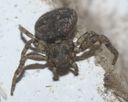Crab Spiders
Thomisidae
Classification
- Phylum: Arthropoda
- Subphylum: Chelicerata
- Class: Arachnida
- Order: Araneae
- Infraorder: Araneomorphae
- Family: Thomisidae
Pronunciation
How to pronounce Thomisidae: //θoʊˈmɪsɪdiː//
These audio files are automatically generated. While they are not always 100% accurate, they are a good starting point.
Images






Summary
Thomisidae, known as crab spiders, are ambush hunters that do not spin webs and are characterized by their crab-like appearance. They are widely distributed and play an important ecological role as predators.
Physical Characteristics
Crab spiders have elongated bodies resembling crabs and typically display dull colors such as brown, grey, or bright green, pink, white, or yellow. They have two longer and more robust front legs, while the back legs are smaller and often covered in strong spines.
Identification Tips
Identification can be aided by observing color changes in species like Misumena vatia to match flower colors. Also, note the shape and position of the legs which resemble crabs. Common genera to refer to include Misumena, Misumenoides, and Misumenops (Mecaphesa).
Habitat
Crab spiders are often found on flowers, tree bark, or soil. They can be seen in open areas as well as in shaded locations among leaves and under bark.
Distribution
Widespread, occurring in various habitats around the world.
Diet
Ambush predators primarily targeting pollinators like bees and butterflies that visit flowers.
Reproduction
Crab spiders produce silk for reproductive purposes but do not spin webs to catch prey. They use drop lines and silk for other functions.
Ecosystem Role
Crab spiders play a role in their ecosystems as predators, particularly in controlling insect populations, especially pollinators.
Cultural Significance
Commonly referred to as crab spiders and known informally as flower spiders, they are part of various ecological studies due to their predatory habits in gardens and agricultural environments.
Health Concerns
Crab spiders are not harmful to humans; however, some distantly related species can be venomous. Overall, human bites from Thomisidae are rare and not a health concern.
Evolution
The family Thomisidae has around 170 genera and over 2,100 species. It includes the incorporated Aphantochilidae family from the late 1980s.
Similar Taxa
Misconceptions
The term 'crab spider' is loosely applied to other spider families that do not belong to Thomisidae.
Tags
- Thomisidae
- Crab Spiders
- Ambush Predators
- Spider Identification
- Ecosystem Role